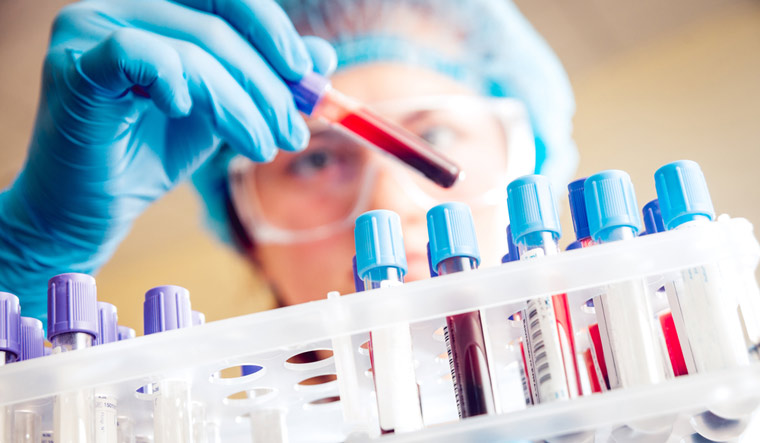In virology, much as in life, seeing is believing. And, inside Dr Atanu Basu’s laboratory at the National Institute of Virology in Pune, the sight is breathtaking. Basu flips through several images of the virus that has brought the world to a standstill, captured by an electron microscope. The electron microscope is a very advance imaging platform that can render extremely high-resolution images of virus particles. A trained expert such as Basu, an expert in virology and electron microscopy, then sifts through the images, zooming in over a million times to hunt for the virus that is 60-80 nanometres and needs to be magnified over 100,000 times. The entire exercise is akin to finding a needle in a haystack.
“It is beautiful,” says Basu, pointing to a grey fuzzball with white spikes on his screen. “This is SARS-CoV-2, the first image of the virus in the country. The white spikes are what makes the virus attach itself to human cells.” The senior scientist has now published the data in the Indian Journal of Medical Research. A few kilometres from Basu’s lab in the NIV's city campus is the institute’s newer facility in Pashan, on the outskirts of Pune, which houses the country’s only biosafety level 4 (BSL-4) laboratory. (BSL-4 is the highest level of bio-containment precautions.) Inside this laboratory, a few scientists work on high-risk viruses such as Zika and Nipah.
As per the risk assessment criteria, the WHO has advised the propagation or isolation of SARS-COV2, in the containment facility. At NIV, the work of isolating the SARS-COV2 virus from clinical samples was done at the biosafety level-4 facility. An isolate, say, experts, is the first step, the base for research on serodiagnostic, drugs, vaccines and evaluating diagnostic tests.
Which is why at NIV, the scientists who have given up their weekends and put in countless hours, are buoyant about the isolation. They have already started studying the virus and analysing its ability to cause disease. The feat, though, did not come easy. Dr Pragya Yadav, senior scientist and head of biosafety level laboratory-4 says, viruses are hard to grow in culture, and hence pose difficulties in the process of isolation, and are hard to isolate. “Viruses are the link between the living and the dead,” she says. “They can only survive in a living host. We had to take extra care that the samples were kept in a proper manner and stored at the appropriate temperature before reaching the laboratory,” she says.
There were other challenges, too. To begin with, what cells would the virus propagate in? In this case, says Yadav, the Vero cells—a lineage of cells used in cell cultures, which was isolated from kidney epithelial cells extracted from an African green monkey—worked, and the contagion started to multiply. The number of samples was a challenge, too, at least, in the initial phase. “First, we tried with the Kerala patients, but we did not succeed because the quantity of virus in the samples was not enough,” says Yadav. “Then the samples came from the Italian patients and others, and we could see the virus was growing and were able to isolate the SARS-CoV-2 from that.” According to Dr Priya Abraham, director, NIV, the samples used were from the throat swabs of eight of the 16 virus-positive patients.
Genomic sequencing and other series of confirmations were done subsequently to prove that the isolate was indeed the virus that they had been looking for. The final day of the results, as with a few other days in an outbreak of this magnitude, too, the team left their workstations at 5 am, says Yadav. But as she and her colleagues at NIV say, they have had similar success in the recent past, too-- the Zika and Nipah viruses were also isolated here, paving the way for further research, especially on vaccines. Between the isolation and readying a vaccine candidate though, it is a long way, and the industry has to step in, too. “In the case of Nipah, we isolated the virus, developed the point of care assay and serodiagnostic assay but we have not reached still for vaccine development," said Yadav.
As of now, Yadav and her colleagues from several departments are working hard to study the virus, and look for clues to the several questions about it that are still confounding researchers across the world. “What we do know about the Indian strain as of now is that it is not very different from the Italian or the Wuhan one,” says Yadav. “The difference in the strain from across the world is within the range of 99.4-99.9.” This is unlike the influenza viruses that mutate each year, and a different vaccine has to be administered to help the body fight the new strain.
For now, much like researchers across the world, scientists at NIV, too, are trying to find answers to confounding questions such as the virus's ability to cause disease, immune responses to the viral attack, the way temperature affects it and beginning to analyse the spread based on mathematical models. “The idea is to keep oneself prepared for the coming months, too,” says Yadav. “Sometimes viruses disappear, only to reemerge after a few months. How this new virus will behave, we just do not know, yet.”



